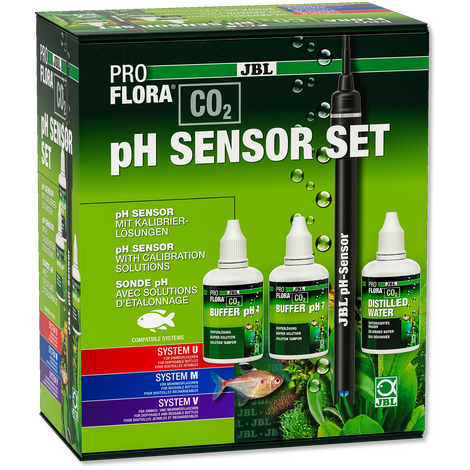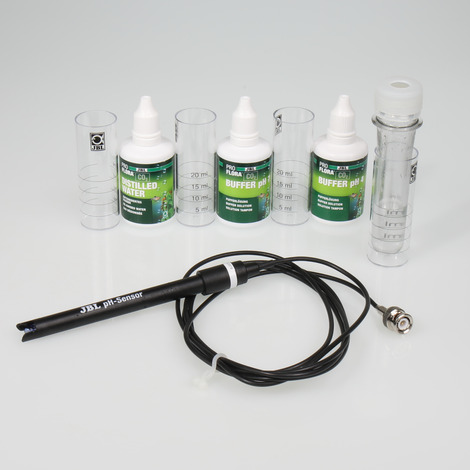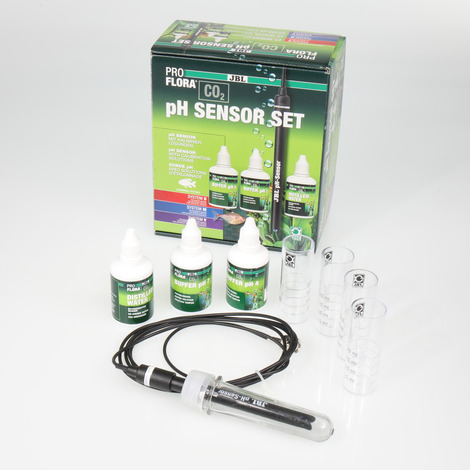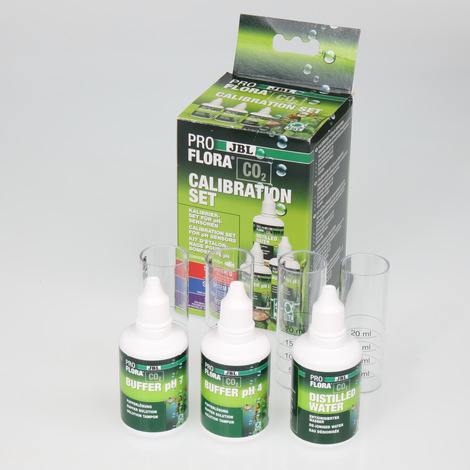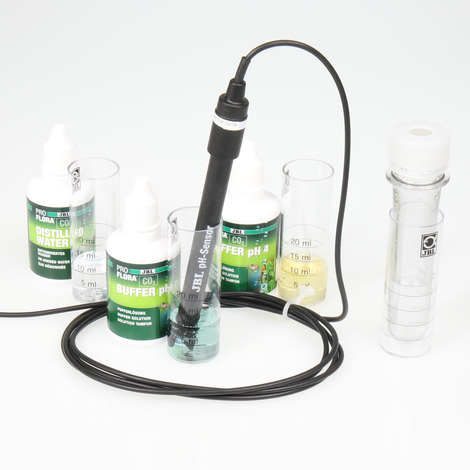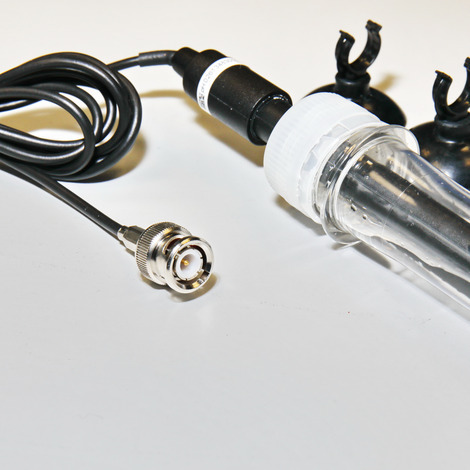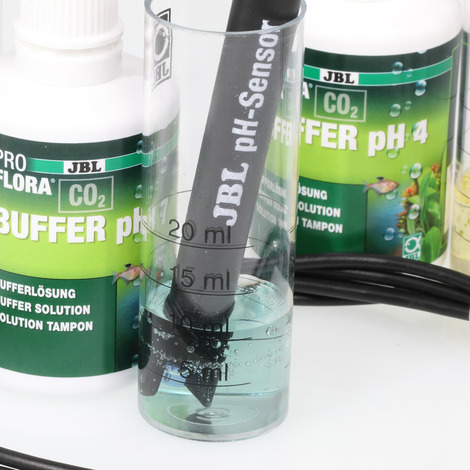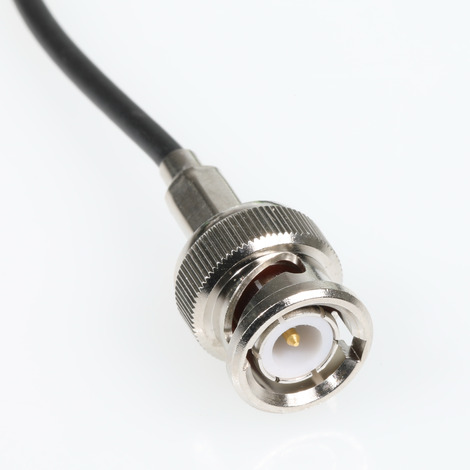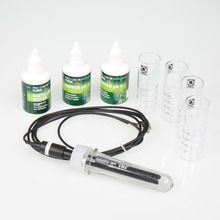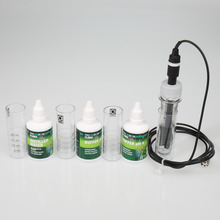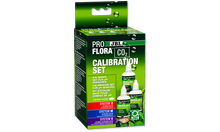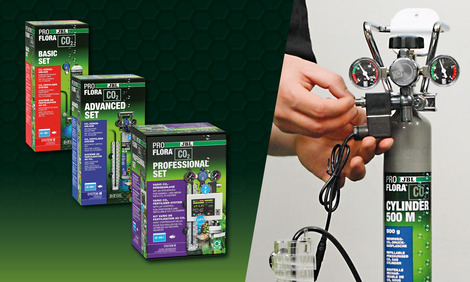Healthy fish thanks to an ideal pH value
The acidity defines the pH value of the water. It needs to be constantly checked and adjusted as necessary to maintain the health of the fish and plants. The correct pH value depends on the fish stock of the aquarium. The wrong pH value can cause stress and disease.
Easy to connect
Connect the pH electrode with the BNC connection to its corresponding measuring and control device. - RELIABLE: The electrode has been individually tested and documented and needs to be replaced after about 2 years. It comes with a large protective cap, filled with storage solution.
pH electrodes:
Every pH control or measuring device and also the JBL pH-CO2 control unit (JBL PROFLORA CO2 CONTROL) requires a pH electrode (JBL PROFLORA CO2 SENSOR) to measure the pH value of the water. pH electrodes age with time and must be replaced about every 2 years. Every 30-45 days the pH electrode needs to be calibrated so that it continues to show accurate values. During calibration, the functionality of the electrode is also checked so that you know when a new electrode is needed. The pH electrodes do not like the addition of medication to the water and need to be placed in a glass of aquarium water during treatments.
Positioning the pH electrode in the aquarium:
Attach the pH electrode with the suction cups supplied ideally to a dark area in the aquarium with little current. Electrodes easily become algae-ridden in very bright locations.
JBL PROFLORA CO2 pH SENSOR SET
Laboratory-quality pH electrode with common BNC connection for most pH device
- Robust quality electrode for the JBL CO2 Control unit and other pH measuring and control devices with BNC connection, incl. liquid for calibration of pH sensors
- Simple connection: connect the electrode via BNC connector to the respective measuring or control device (not supplied)
- Large protective cap filled with storage solution, plastic shaft and gel filling, suitable for many systems with BNC connector
- Individually tested with an individual test report
- Package contents: pH electrode, 2 m cable, 2 suction holders for attachment, 3 cuvettes, 50 ml cylinders: storage solution, distilled water, calibration liquids pH 7.0 and 4.0

Visit our premium partners to fill / exchange your CO2 cylinders and purchase products from the JBL PROFLORA CO2 range.
You may also be interested in
JBL PROFLORA CO2 pH SENSOR SET
Properties
| Animal species: | Arowana, Axolotl, Barbels, Bettas, Bichirs/reedfish, Blowfish, Catfish, Cichlids (South America), Crayfish, Danions, Discus, Dwarf shrimps, Flowerhorn, Goldfish, Gouramis, Guppy, Juvenile fish, Killifish, Livebearers, Loaches, Panchaxes, Rainbowfish, Snails, Spiny eels, Tetra, Veiltails, freshwater butterflyfish |
| Animal size: | For all animal sizes |
| Animal age group: | All aquarium fish |
| Volume habitat: | For all aquariums |
| Material: | Plastic (PVC), plastic (PE), plastic (ABS), metal (copper) |
| Colour: | white / transparent / black |
Electronic label / illuminant
| Mercury: | No |
| Dimmable: | No |
Technical Data
| Height: | 12 mm |
| Length: | 160 mm |
| Width: | 16 mm |
All pH sensors (electrodes) are wear parts and are subject to natural ageing. JBL grants a 6-month guarantee if the sensor is put into operation before the stated MIN date. The purchase receipt serves as proof.
No, don't worry. The MIN date on the packaging is not a BBD (best before date), but the date of the latest intial operation to guarantee 6 months warranty and 1 year operation. This information can also be found on the product packaging. Everything is therefore in order.
Yes, the JBL PROFLORA CO2 products are designed exclusively for use in the aquarium. The gas contained promotes plant growth and works with fine precision so that even the smallest quantities can be supplied to the aquarium. Constant operation and the safety of the fish are thus guaranteed.
The cause can probably be fixed quite easily. The protective cap of the pH sensor needs to be removed before insertion into the aquarium / before the calibration, to carry out control / calibration correctly. The protective cap serves as storage and “reactivation” of the sensor with the storage liquid. It has to be removed for use inside the aquarium and during the calibration because no water from outside can pass through.
If the controller still displays an error, even after the removal of the protective cap, please read the FAQ with the several error messages in detail.
It is difficult to give a precise answer without information about the sensor, particularly the age of the sensor. Good sensors have deviations in the range from 0.02 to 0.05 pH levels when calibrating.
The input voltage differs for each sensor, as each sensor has its own individual properties. For the majority of our sensors, it is between -30 and +30 mV at pH 7.
Both input voltages (pH 7 and pH 4) are important when assessing the quality of a sensor. The greater the difference between these two values, the better the sensor and the precision of the measurement and control. The differences should be over 140-150 mV.
The temperature sensor should always be used during calibration. The pH level varies according to temperature, so that it is always best to measure the pH level with temperature compensation. The deviation is between 20 and 30 °C, 0.17 pH levels, and the relationship is nonlinear.
The cable has a length of 2m.
The message INSTAB indicates: instable sensor voltage: the sensor tip is dirty, the electrolyte has leaked from the sensor, the sensor tip is damaged.
Remedy: Clean the sensor head (see the respective instruction), put the sensor into the storage solution for 24 hours and repeat the calibration. If this does not work the sensor is defective and should be replaced.
The message OFFSET indicates: The sensor voltage at pH 7.00 is outside the limit value, the sensor is too old, the cable is defective, no sensor is connected or the calibration has been performed with buffer 4 solution.
Remedy: Check the sensor cable for any signs of damage and repeat the calibration. Take care to use the buffer solution correctly. If this does not work, replace the sensor and calibrate again.
This message indicates that the potential difference per full pH unit is smaller than 30 mV. The pH sensor is either too old, defective or was accidentally calibrated twice with the same buffer solution.
Remedy: Repeat the calibration and take care to use the buffer solution correctly. If this does not work, connect a new sensor and calibrate again.
In the menu you have the chance to choose the interval before the next calibration reminder. The following calibration intervals are available:
30 days
45 days
60 days
However it is highly recommended not to select the 60 days setting, since each pH sensor wears continuously and the measured values become subject to change. Thus the more often you carry out a calibration the more reliable are the measurement results.
It is a harmless fungus which will disappear on its own after a while.
You need a separate soleniod valve (JBL ProFlora v002 or JBL PROFLORA CO2 VALVE) to control the CO2 supply. A further night switch-off for CO2 systems, controlled by a pH control unit is not needed, as the CO2 supply will not be turned on in the absence of CO2 consumption, or it will happen less frequently when CO2 degassing occurs at the water surface. That is why the control units do not need a timer
Reviews
0 Reviews
5 more reviews in other languages
5 Reviews in other languages
Sehr gute Haltbarkeit ! Bei mir über ein Jahr im Gebrauch und immer noch im sehr guten Toleranzbereich.
kocham ! najlepszy!bardzo bardzo polecam
super produit
Facile d'utilisation et tres precis
je recomende ce produit a 100%
great product
easy to use and very precise
I recommend this product 100%
Beste Qualität 👍
Habe diese Sonde zu meiner PH Control Anlage benötigt. Sehr einfach zu kalibrieren uns auch die Messung ist sehr genau. Super👍
